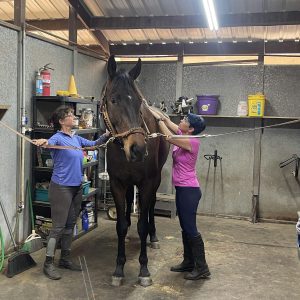Saddle fitting can take time. To ensure you and your horse get the best experience follow these steps to prepare.
- It may help to lunge your horse or otherwise check for soundness on the day of the fitting. It is difficult to assess a saddle on a horse with mild lameness.
- Choose a clear, level area for the assessment, like a wash rack, tacking area, barn aisle. It’s best if this is not a high traffic area so your horse and your fitter can focus.
- Make sure your horse is clean, relaxed, and ready at hand. If the fitting schedule may intersect with regular feed times it may be best to feed early.
- Have all necessary tack for riding on hand near the work area, but do not tack your horse. This includes items such as your helmet and boots.
- Your assessment will follow these steps:
- Assess the horse standing with no tack
- Assess the saddle
- Assess the saddle on the horse with no pad or girth
- Assess the saddle standing with pad and girth
- Assess the saddle ridden
6. The unexpected can occur. If this is the first time your saddle has been assessed, there is a chance it can not pass the static fit test. If you haven’t had your saddle fit regularly, then be prepared with other options. Let the fitter know your potential budget ahead of time if you’d like to see saddle options, or have other saddles on site to check. Ideally, your fitter will leave you with a well-fitted saddle ready to ride, but you will at least have a list of specifications and potential models to look for.
7. Don’t forget to schedule your next appointment. Saddle fitting regularly ensures the best fit over time, and helps maintain your saddle’s longevity
